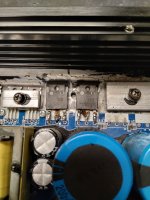I had a Sundown SFB-8000D amp come into the shop yesterday that wasn't giving any output. The guy who brought it in said he bought it off some crack head on Facebook marketplace for a good price, but bought it knowing it was broken. Apparently the original owner was cutting out the transistors to the right of the ones pictured whenever one would blow and take the output out. Best I can figure he also cut the legs on the S5 and S6 ic's as well and soldered them back together.
My problem is Sundown decided in the factory to remove the original markings on the IC's and now I can't figure out what the transistor is supposed to be. Looking this forum I managed to find the missing transistors (which are labeled D1 instead of having part numbers) are IRFP90N20D and the driver IC's (which are also burnt up) are Irs20957s.
The transistors in the photo aren't testing faulty I just don't like the idea of taking all the time to source the missing and blown components and leaving these in in their current state.
I appreciate any and all help.
My problem is Sundown decided in the factory to remove the original markings on the IC's and now I can't figure out what the transistor is supposed to be. Looking this forum I managed to find the missing transistors (which are labeled D1 instead of having part numbers) are IRFP90N20D and the driver IC's (which are also burnt up) are Irs20957s.
The transistors in the photo aren't testing faulty I just don't like the idea of taking all the time to source the missing and blown components and leaving these in in their current state.
I appreciate any and all help.
Attachments
Are those rectifiers? You should be able to tell if they're rectifiers by their connection to the other components (rail caps?) and by the readings with your multimeter.
No matter what they are, you can salvage them. For parts that were not available, I used to drill the legs, run wire through them and solder that to the board. If done carefully, it looks OK and worked for me.
No matter what they are, you can salvage them. For parts that were not available, I used to drill the legs, run wire through them and solder that to the board. If done carefully, it looks OK and worked for me.
I was thinking of doing this if I couldn't find replacements for them since they aren't blown and are most likely ok if not a little uglier now than they used to be.No matter what they are, you can salvage them. For parts that were not available, I used to drill the legs, run wire through them and solder that to the board. If done carefully, it looks OK and worked for me.
I haven't pulled the board yet to measure what they're connected to, but from looking at the board briefly yesterday and taking another photo the emitter of the S5 transistor is connected to the emitter of the D1 at Q16 for sure. I'm assuming right now that the S5 and S6 transistors are connected to the large caps at some point, but I won't know that for sure until I pull the board tomorrow when I go into work ( today and yesterday are my days off so I can't really get much better pictures and info at the moment).
S5 and S6 are bridge rectifiers. On the opposite side, you will find them as well. Compare them. I never came across any of those rectifiers going faulty.
Check the output fets You can also use IRFP4227 for output fets.
Check the output fets You can also use IRFP4227 for output fets.
The S5 and S6 haven't gone faulty I just don't like the idea of leaving it in the unit with the legs all chopped up and soldered like that and if I'm already looking at ordering 10 of the fets I figure may as well add a couple of other transistors in with it. If I do end up leaving them though I will absolutely be tidying up the legs so they don't look so mangled.S5 and S6 are bridge rectifiers. On the opposite side, you will find them as well. Compare them. I never came across any of those rectifiers going faulty.
Check the output fets You can also use IRFP4227 for output fets.
Looking online I see that the IRFP4227 is cheaper, but also has an amp rating of 65A rather than the 90A rating of the IRFP90N20. I doubt this thing would pull 65A or 90A, but would the higher current capacity help the fets to last longer in this application? I'm more familiar with stepping up amp ratings on PSU's than I am in amps.
